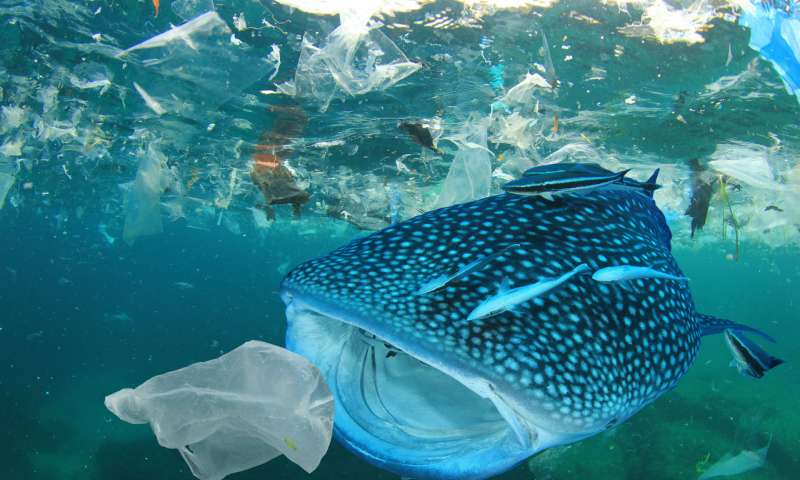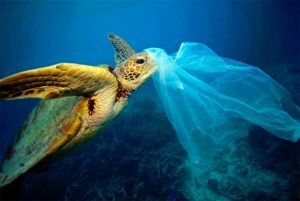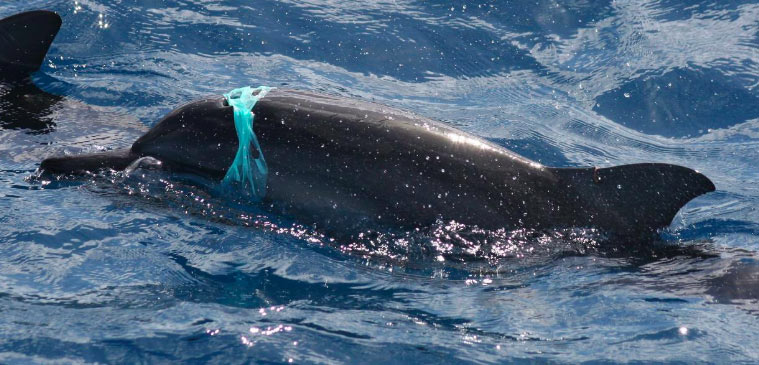Our oceans are awash with plastic. In a recent study, it was estimated there are between fifteen and fifty-one trillion individual pieces of plastic in the world’s oceans. That’s more pieces of plastic than there are stars in the Milky Way.
In this article, we will look at the ways in which marine life is being affected by widespread plastic pollution.
The problem with plastic
Plastic is an incredible material – durable, flexible, cheap and hard-wearing. Unfortunately, the world is suffering from a case of “too much of a good thing”. Because it is so cheap, plastic products became disposable.
And when it gets disposed of, plastic has a habit of finding its way into the ocean.
In fact, more than 80% of the plastic in the oceans comes from land-based sources. It enters rivers, or goes down drains, and works its way out to sea.
Once there, they stick around for a long long time. Plastics do not decompose in the same way as organic materials such as paper or wood. Rather, plastic breaks into smaller and smaller pieces over time.
Once these tiny plastic particles are measured at 5mm or under, they are classed as microplastics.
This means that our oceans are polluted with plastics of all sizes; from large bottles and fishing equipment to microscopic microplastic particles.
So what effect is this having on our marine life?
Fish

In 2017, marine scientists from the National University of Ireland Galway looked at the contents of fish in the Northwest Atlantic Ocean.
73% of the 233 fish they examined contained microplastic particles.
There was nothing special about this patch of the ocean, nor about the fish they examined. The fish were caught from depths of up to 600 metres and ranged in size from 3.5cm to 59cm.
Alina Wieczorek, the lead author of the study, said
“DEEP-WATER FISH MIGRATE TO THE SURFACE AT NIGHT TO FEED ON PLANKTON (MICROSCOPE ANIMALS) AND THIS IS LIKELY WHEN THEY ARE EXPOSED TO THE MICROPLASTICS,”
Fish Food
And it turns out that some fish may actively seek out plastic, because the tiny particles smell similar to their natural prey.
They acquire this smell because microplastics can pick up a covering of algae, which mimics the smell of food. This process is called “biofouling”.
In a recent study, scientists presented schools of anchovies with pieces of plastic taken from the ocean, and with pieces of clean, new plastic that had never been in the ocean. The anchovies gravitated towards the smell of the ocean plastic, mistaking it for food due to the smell it gave off.
This was seen as a worrying discovery because it turns out that fish are not just accidentally swallowing plastic, they are actively seeking it out.
Smaller, slower, and more stupid
Swedish researchers from Uppsala University recently looked at the effects of perch when exposed to water containing microplastics.
In clean water that did not contain microplastics, about 96% of perch eggs hatched successfully. Compared to just 81% of eggs when the perch were in water containing large quantities of microplastics.
The fish that did hatch in the water with high a concentration of plastics were described as “smaller, slower and more stupid” than those hatched in water not containing plastic.
What’s more, about half the perch from clean water were able to evade predators for 24 hours. The perch raised in water containing microplastics were all eaten by pike in the same time period.
The research suggests that microplastics can have a major impact on the ability of fish to function as they should.
The damage being done
When plastic is ingested by fish, it can cause significant internal physical damage, including intestinal inflammation.
If a fish’s stomach becomes full of plastic, it can reduce their desire to feed, which can cause them to starve to death.
Another concern is that many of the microplastics being ingested contain additives, such as colorants and flame retardants.
Turtles

Sea turtles are incredible creatures. They have been around for roughly 110 million years – they existed at the same time as dinosaurs walked the Earth.
Sea turtles are at risk from plastic pollution in multiple ways.
Entanglement
According to a report by World Animal Protection, around 700,000 tons of fishing gear is dumped into the ocean every year. Once abandoned, this fishing gear is called “ghost gear”.
The nature of fishing gear means that it easy for marine life to become entangled. It is designed to capture marine life, and it’s very good at doing so.
Because of their long, paddle-like flippers, sea turtles are extremely susceptible to becoming tangled in fishing fear.
Once entangled, they become considerably less mobile and can drown within minutes. Or due to their impaired mobility, they can become easy prey for predators.
Ingestion of plastic
A large part of the sea turtles diet is jellyfish. Sadly, to a sea turtle, a plastic bag floating in the ocean can easily be mistaken for a jellyfish.
Plastic bags are one of the most commonly found types of plastic pollution. A staggering 1 trillion of them are produced each year, and they can take up to 1000 years to decay.
There are literally millions of them floating in the sea.
According to studies, a single piece of plastic is enough to kill a sea turtle.
There is a one in five chance of death for a sea turtle that consumed a single piece of plastic. That rises to 50% for a turtle that consumes 14 pieces of plastic. If the turtle consumes more than 200 pieces of plastic, death becomes inevitable.
The authors of the study estimate that roughly half of all sea turtles in the ocean have ingested plastic at least once in their lives.
Because of the way a sea turtle’s digestive tract works, they do not regurgitate anything. Which means that if they mistakenly ingest a plastic bag, it is in there for life.
Plastic can block the digestive tract of the turtle, meaning no other food can get through. This will often lead to death.
Seabirds

It’s not just the animals that live in the sea that are affected by plastic pollution, it’s also the animals that fly over it.
A scientific study carried out by CSIRO estimated that as many as 9 out of 10 seabirds are likely to have plastic in their guts.
A previous estimate put the figure closer to 29%, but their new study discovered the problem is far more prevalent than first thought.
Study author Denise Hardesty described the results as “pretty astronomical”.
Other findings from the study included:
- Birds mistake plastic for fish eggs, so they think they are filling themselves up
- An entire glow stick and three balloons were found inside a single bird
- The lead scientist predicts that by 2050, 99% of seabirds will have plastic in their guts
- The average shearwater chick had between 30 and 40 pieces of plastic inside their stomachs.
- A young bird was found with 260 pieces of plastic inside it
Filling up on plastic
Many seabird species are “generalist predators” which basically means they are not picky. They’ll eat whatever they can find, so long as it resembles food to them.
Similarly to fish, seabirds can also fall foul of the process of “biofouling”, whereby plastic becomes covered in a coating of algae. The smell of the algae means birds often treat small plastic particles as food.
Sharp, jagged pieces of plastic can puncture the intestines or stomachs of seabirds and can result in a slow, painful death.
Parent seabirds will often feed plastic to their chicks, which means the chicks are not receiving sufficient nutrition in the early stages of their life. This makes them too weak to be able to begin foraging for themselves, and can all too often result in early death.
Plastic will also fill up the stomachs of seabirds, meaning there is less space for actual food. The birds will feel artificially full and will not seek out more food.
Facts about seabirds and plastic
- An estimated one million seabirds die as a result of plastic every year
- Some of the plastics found inside birds include plastic bags, bottle caps, nurdles, and synthetic fibres from clothing
- The highest concentration of plastic in birds can be found in southern Australia, South Africa and South America.
Whales, sharks and dolphins

Between 5 and 13 million tonnes of plastic ends up in the ocean every year. That’s more than the combined weight of every single blue whale on Earth entering the ocean every year.
Certain species of sharks and whales are “filter feeders”. This means they feed by straining food particles from water. To accomplish this, they ingest huge quantities of seawater every day.
Filter feeder animals include whale sharks, blue whales, basking sharks, humpback whales, fin whales, minke whales, and many many more.
With so many tiny microplastic particles in the world’s oceans, it is no surprise that filter feeding animals are ingesting vast quantities of microplastics.
